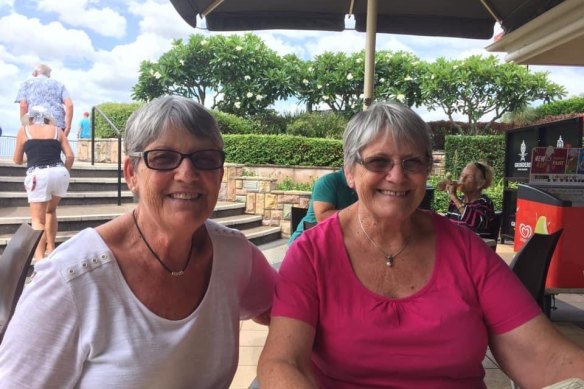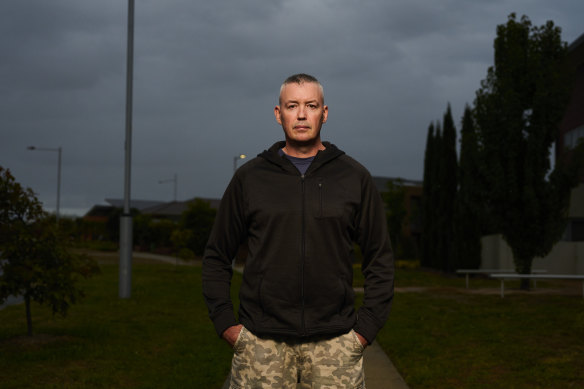- Investigation
- National
- NSW
- Hospitals in crisis
This was published 2 years ago
‘Total disbelief’: Unnecessary medical test killed Carmel Haynes
Carmel Haynes gave her son a peck on the cheek and promised she’d see him soon before she vanished down a corridor at Orange Hospital.
Thirty minutes later she was dead. And nearly 18 months since that day, Carmel’s horrifying final moments still play out in her son Matthew Haynes’ nightmares after he discovered that the procedure that killed his mother should never have taken place.

Carmel Haynes (right) with her twin sister, Rose Carroll, with whom she was inseparable. Carmel died during an unnecessary procedure at Orange Hospital in 2021.
Carmel attended the hospital’s medical imaging department for a CT-guided biopsy on February 8, 2021. The relatively quick procedure didn’t require admission and could be performed under local anaesthetic.
“The doctor explained to her that she’ll be conscious the whole time,” Matthew recalled. “And to signal with her hand if she felt uncomfortable.”
As a slender needle was passed into Carmel’s lungs to retrieve a sliver of tissue, the procedure went catastrophically wrong.
The needle punctured a blood vessel and the 66-year-old’s lungs filled with blood while she was face down on the radiologist’s table. She went into cardiac arrest and died.
For Matthew, thoughts of his mother’s suffering are almost unbearable.
“She would have been signalling, she would have been struggling,” he said. “She was fighting for her life.”
Matthew said he had to fight “tooth and nail” for answers over what happened to his mum. The coroner declined to investigate and he was denied an autopsy because the death was attributed to natural causes.
When he eventually obtained the hospital’s internal investigation report, he was blindsided to discover the biopsy that killed his mother was unnecessary and only happened because of a communication breakdown.

Matthew Haynes said he had to fight “tooth and nail” for answers over his mum’s preventable death. Credit: Rohan Thomson
Carmel Haynes’ death is one of four potentially preventable deaths in regional NSW hospitals uncovered by a Herald investigation that have not received any external scrutiny beyond the local health districts they occurred in.
In all cases, the Coroner was either not notified or chose not to investigate.
They include the death of a man who fell out of bed after a mandatory falls risk assessment was not carried out, the death of a woman with a torn oesophagus following elective surgery and the death of a man with fatally high potassium levels after hospital staff did not act on abnormal pathology results.
A recent parliamentary inquiry into regional health, sparked by a Herald investigation, recommended a new Ombudsman be created with powers to independently investigate preventable deaths. However, senior clinicians have expressed concerns the role would not be adequately resourced to investigate the cases in a systematic way.
The families have expressed deep unhappiness with the way the deaths had been handled, and lack confidence in the local health districts’ internal investigations, known as a root cause analysis or serious adverse event review.
That was unsurprising to Newcastle-based medical negligence lawyer Catherine Henry, who also acts as the Australian Lawyers’ Alliance’s spokesperson on regional health.
She describes the deaths uncovered by the Herald as terrible.
“The root cause analysis, it’s often useful, and makes the bureaucrats feel like they’ve done something,” Henry said.
“But it’s ultimately not satisfactory to people who have been through the serious injury or death of a family member.”
She said families were usually seeking accountability and changes in processes that would prevent the same thing happening to others.
“The root cause analysis is performed by people employed by the local health district which is responsible for this thing happening in the first place,” she said.
“It’s not an appropriate complaint model.”
A spokesman for the Western NSW Local Health District described Carmel Haynes’ death as a devastating event and offered condolences to her family.
He said the local health district had an “absolute commitment to clinical safety”.
“Health services in NSW are subject to stringent requirements to review and act when serious, unexpected patient outcomes are experienced.”
The spokesman said all recommendations of the internal review had been implemented and a meeting had been held with Carmel’s family.
“NSW Health policy specifies that review team members should not have been central to the patient’s care or directly involved with the incident, and at least one team member should be external to the facility.”
A cherished sister
Carmel Haynes relished the simplicity of life in her rural hometown of Forbes, in the NSW Central West. Days working at the local retirement village were punctuated by evening strolls along the grassy banks of the Lachlan River with her twin sister, Rose Carroll.
The pair, who sported matching tattoos on their arms, were inseparable.
“We had babies together, we got divorced about the same time, we worked together,” said Carroll, crying. “I can’t explain my loss.”
After abnormal blood test results in January 2021, Carmel underwent a scan which showed a large mass in her lung.
Orange Health Service’s cancer services team arranged a biopsy via ultrasound on January 25, which confirmed a diagnosis of lung cancer.
Carmel was then booked for a second biopsy a fortnight later – the CT-guided procedure that killed her.
An internal investigation into Carmel’s death, known as a serious adverse event review (SAER), found clinicians who booked the second biopsy were unaware of the first.
“The SAER team determined a breakdown in communication to be a contributing factor in the patient’s death as the CT-guided lung biopsy was not necessary to guide future treatment,” the review said.
It recommended systems improvements so that previous results were obvious to parties booking biopsies.
The clinician who booked the second procedure was covering for a colleague on leave and may have been suffering “cognitive overload”, the review found.
Carroll recalled being called in with other family members to see her sister’s body in the immediate aftermath, while doctors were justifying what happened.
“They were talking so matter of fact, and Carmel was laying dead next to us,” she recalled.
“We were in total disbelief. It was a simple biopsy and now she’s dead.”
Two police officers arrived and offered an autopsy, to be carried out in Newcastle.
The family was later informed there would be no autopsy because the assistant coroner was satisfied the death was due to natural causes. The family was also denied an inquest in a letter from the State Coroner’s office.
“Approximately 6000 deaths are reported to the Coroner each year and only a very small proportion can proceed to inquest,” it said.
Matthew Haynes said: “It went from everything’s got to be done by the book, to the book is closed and here’s your mum.”
The hospital’s internal review found Carmel died from “a known albeit rare complication” of the procedure and her internal bleeding “was managed proficiently but without success”.
While it was unable to identify a root cause for Carmel’s death, it found communication breakdowns contributed and there were multiple opportunities for systems improvement.
The review noted a screen monitoring Carmel’s vital signs was not visible to all the clinicians in the room, which had no bearing on the outcome but should be remedied.
Clinicians also told the reviewers that the medical imaging department was understaffed, and that while two clinicians were present for Carmel’s procedure, that was not always the case.
The review team found staffing was not a contributing factor in Carmel’s death and staffing levels were adequate.
The review also played down the relevance of another death during the same procedure at another hospital in the local health district in 2019, finding it occurred in different circumstances.
Carmel’s death certificate listed the cause of death as “complications of lung malignancy and the treatment thereof”, infuriating Matthew who pointed out she never began treatment because of time wasted performing unnecessary tests.
“Mum should have been able to go on her own terms and if the treatment wasn’t working, then that’s a decision that mum could have made herself,” he said. “She didn’t get that chance.”
He expressed frustration that the family had been forced to rely on the hospital’s account of events.
“Time just goes by and the wounds heal, but there’s always that thing in the back of your mind. Like, I wonder what happened that day? We’ll never know.”
Carmel’s niece, Ayleen Tisdell, said she felt the family had been “totally robbed of their goodbyes to their mum”.
‘You’ve got to fight’
Lawyer Catherine Henry said inquests were pivotal for questionable deaths where lessons need to be learnt by institutions. However, she had observed dwindling numbers being held during her decades of practice.
“Once upon a time inquests were relatively commonplace,” she said. “Now you’ve got to really fight.”
Henry drew attention to evidence to a recent parliamentary inquiry, which heard that in regional areas, coronial work is shouldered by local court magistrates who hold few inquests and rarely make recommendations.
She described it as scandalous that NSW’s expenditure on coronial services was $6.9 million in 2019/2020, compared with $21.5 million in Victoria and $12.4 million in Queensland, according to a productivity commission report.
In some instances, unexpected deaths are not referred to the coroner at all, such as the death of an Aboriginal man, 74, at Cobar hospital in Western NSW.
The Herald has not named the man at the family’s request.
A damning internal investigation report, known as a root cause analysis, details a litany of failings in the care of the man, who presented to emergency with shortness of breath in November 2018.
The report found the patient went into cardiac arrest and died after the hospital failed to recognise and adequately manage high potassium levels in his blood, a condition known as hyperkalaemia.
The investigation found the hospital had “no formal process for review and actioning of abnormal pathology results” and handover processes between staff were not in line with minimum standards set by NSW Health.
The patient’s medication chart and Webster pack were placed on a desk away from him in another room, alongside medications belonging to another patient.
“This resulted in the incorrect medications being prescribed and administered to the patient and his usual medications being missed that morning,” the report said.
“This was not in line with best practice.”
The medication error was subsequently recognised and corrected by staff, and was not found to have contributed to the patient’s death.
A spokesman for the Western NSW Local Health District offered its sincere condolences to the patient’s family and said it “enacts strict processes and procedures to review any serious, unexpected patient outcomes.”
The spokesman said deaths were to be reported to the coroner if they were unnatural, the cause was unknown or they were not the reasonably expected outcome of a health-related procedure. The patient’s death did not fit into any of those categories, he said.
The spokesman said all recommendations of the root cause analysis had been implemented and the local health district had met with the patient’s family.
“The district is committed to listening, learning and making any necessary changes to
improve process and address potential for system or human error to ensure adverse patient
outcomes are avoided wherever possible.”
The Morning Edition newsletter is our guide to the day’s most important and interesting stories, analysis and insights. Sign up here.